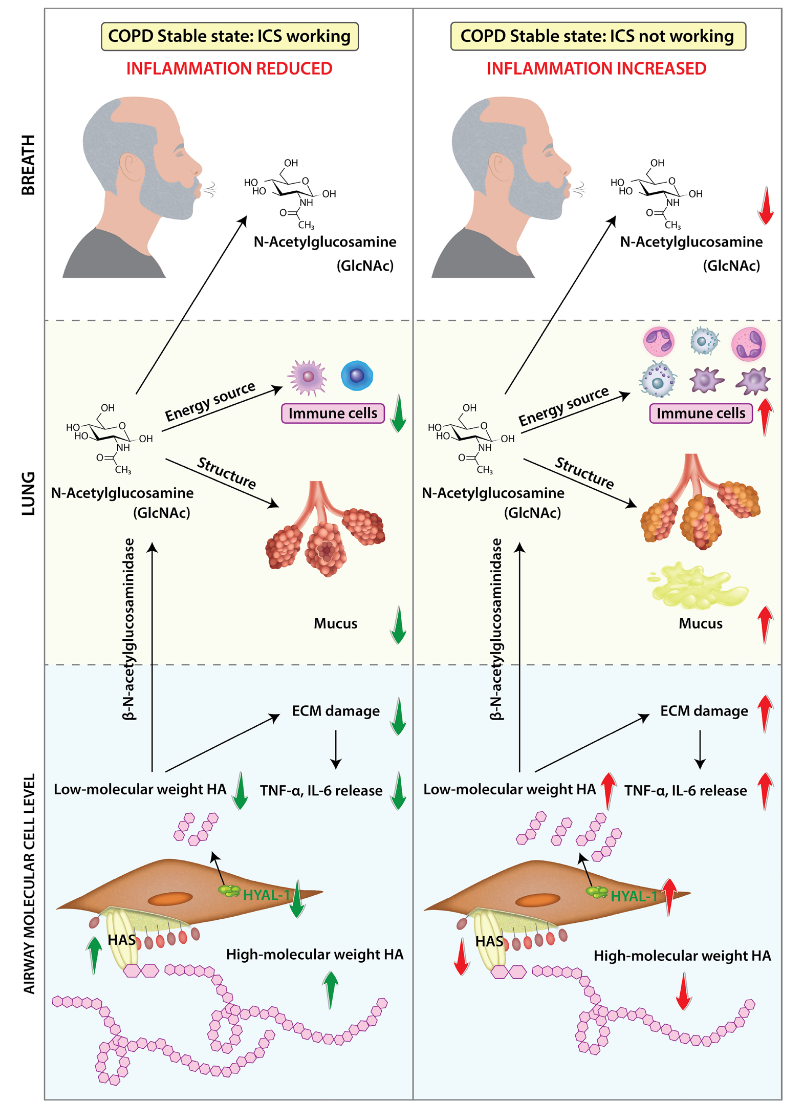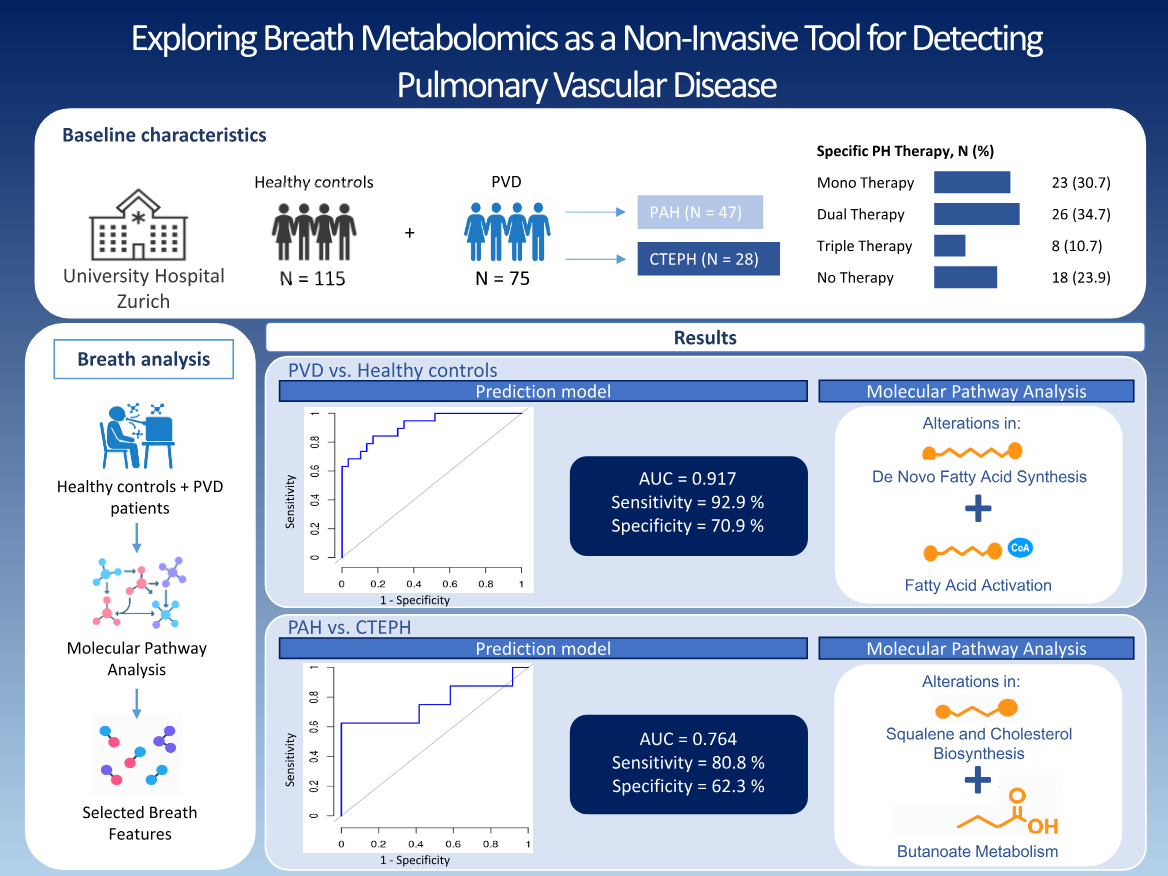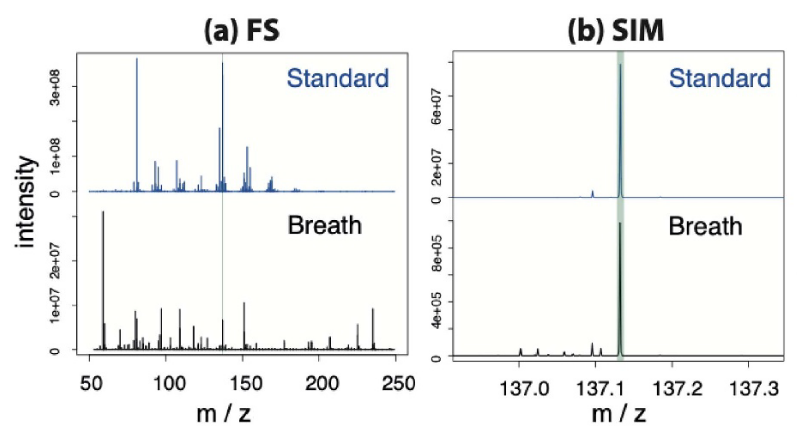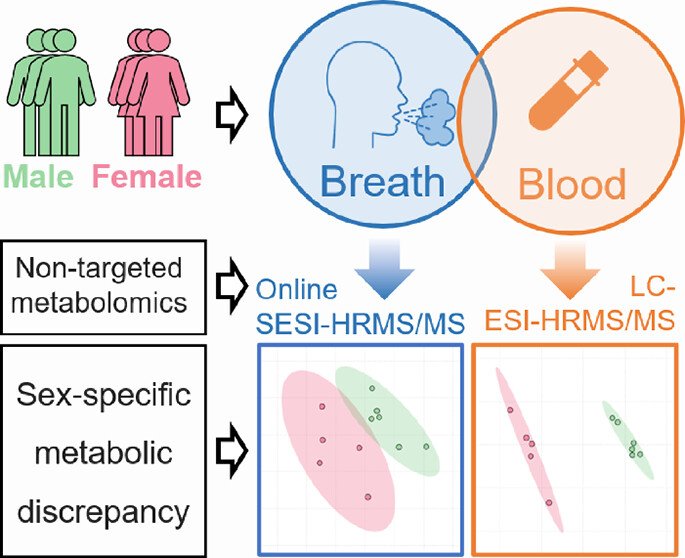Breathprints of the Barn: The Future of Livestock Research and Monitoring with Exhalomics
M. Niu, U. Arshad, M.Z. Islam1, M.A. Barrientos-Blanco, E. Slack, S. Giannoukos, R. Zenobi
Exhalomics: advancing noninvasive monitoring in livestock health and welfare
This review highlights exhaled breath analysis (“exhalomics”) as an emerging noninvasive approach for monitoring livestock health, metabolism, and welfare. It synthesizes advances in sampling and analytical techniques, outlining applications in disease detection, nutrition assessment, and physiological and microbial profiling across animal species. Despite promising progress, the field faces challenges in standardization, metabolite identification, and scalability for farm use. The integration of exhalomics with multi-omics and AI-driven analytics is poised to transform precision livestock farming by enabling earlier disease detection, improved productivity, and enhanced animal welfare.
Real-time breath drug metabolic monitoring under stellate ganglion block with lidocaine: a proof-of-concept study
Z. Yin, W. Xiong, K. Zhang, X. Luo, M. Wei, K.D. Singh1,2, U. Frey, X. Li, X. Feng, and P. Sinues
Breath metabolomics under lidocaine-SGB
This pilot study provides the first real-time metabolic profiling of lidocaine-based stellate ganglion block (SGB) using high-resolution breath analysis (SESI-HRMS). In 28 participants, more than 300 metabolites were significantly altered after lidocaine injection, including both drug-derived compounds and endogenous metabolites linked to fatty-acid oxidation and amino-acid metabolism. The findings demonstrate that breath metabolomics can simultaneously capture drug metabolism and host physiological responses, while revealing notable inter-individual variability. This work positions breath-based pharmacometabolomics as a promising tool for personalized monitoring and optimization of SGB interventions in clinical practice.
Acute COPD exacerbation despite triple inhaled therapy: a molecular insight – TripleEx study
N.A. Sievi, F. Schmidt, K. Fricke, D.M. Baur, S. Basler, J. Herth, M. Kohler
Breath metabolomics in COPD exacerbations
This study examined whether real-time breath analysis can detect metabolic changes during acute exacerbations of COPD (AECOPD) compared to the stable state in patients receiving triple inhaled therapy. Breath profiles from 28 patients revealed alterations in aminosugar, linoleate, and butanoate pathways. A prediction model discriminated AECOPD from stable state with high accuracy (AUC = 0.84, sensitivity and specificity 86%). These findings suggest that exhaled breath analysis may provide a rapid, non-invasive tool for detecting exacerbations and reveal aminosugar metabolism as a potential therapeutic target.
Metabolite Fusion between Breath and Blood Enables More In-Depth Understanding of the Endogenous Metabolome
Z. Tang, J. Yang, B. Su, X. Xu, X. Luo, H. Wang, K. Zhang, T. Huan, P. Sinues, M. Fang, X. Li
Breath Metabolomics Beyond Blood
This study demonstrates how exhaled breath can complement blood in metabolomics by retaining volatile compounds often lost in blood analysis. Researchers combined a controlled exercise protocol, a custom breath metabolomics database, and metabolite fusion across breath and blood to boost identification accuracy. High-resolution MS revealed 66 unique breath metabolites, 59 unique blood metabolites, and only 4 shared. Integrating both matrices expanded pathway coverage and highlighted breath-specific markers of exercise-induced changes, paving the way for novel biomarkers and future smart wearable applications.
Exploring exhaled breath biomarkers for lactose intolerance diagnosis: the Lactobreath pilot study protocol
S. Giannoukos, K. J.e Burton-Pimentel, R. Guillod, G. Vergères, D. Pohl
The Lactobreath study explores real-time breath analysis as a novel, non-invasive tool to detect lactose intolerance. In this double-blind trial, 120 participants undergo postprandial testing with lactose or glucose. Using Super SESI-HRMS, the study captures detailed exhalome profiles and correlates them with symptoms, hydrogen levels, gut transit (via ingestible gas capsules), bowel sounds, urine metabolites, and genetic markers. This integrative approach aims to move beyond standard hydrogen breath tests and validate molecular breath signatures as clinical biomarkers for food intolerance.
Exploring breath metabolomics as a non-invasive tool for detecting pulmonary vascular disease
S. Basler, K. Fricke, N.A. Sievi1, A. Arvaji, F.Schmidt, J. Herth, D.M. Baur, M.Kohler, S.Ulrich, and M. Lichtblau
Breath metabolome profiling for pulmonary vascular disease detection
This study evaluated whether real-time breath analysis could identify metabolic differences between patients with pulmonary vascular disease (PVD) and healthy controls, and distinguish between two major subtypes: pulmonary arterial hypertension (PAH) and chronic thromboembolic pulmonary hypertension (CTEPH). Using metabolomic prediction models, breath profiles from 75 patients and 115 controls were compared. The models achieved high accuracy in detecting PVD (AUC = 0.917) and moderate accuracy in differentiating PAH from CTEPH (AUC = 0.764). Pathway analysis revealed alterations in fatty acid metabolism. These findings highlight the potential of breath analysis as a non-invasive, real-time diagnostic tool for early detection and subtype differentiation in PVD.
A sampling method for differentiating breath and ruminal exhaled volatile organic compounds in dairy cows using methane as a marker
M.A. Barrientos-Blanco, U. Arshad, S. Giannoukos, M.Z. Islam, C. Kunz, R. Peng, S.E. Räisänen, R. Zenobi, M. Niu
Separating Breath from Eructation: Advancing SESI-Based Breathomics in Dairy Cows
This study establishes a validated sampling method to distinguish true breath (BR) from ruminal eructation (RE) in dairy cows—an essential step for applying breathomics in ruminant metabolic research. Using a CH₄-based threshold and the GreenFeed system, researchers collected BR and RE samples from Holstein cows and analyzed them via SESI-HRMS and GC. CH₄ levels were 80% lower in BR, confirming successful separation. SESI-MS detected hundreds of VOC features, with distinct profiles between BR and RE. RE was enriched in VFAs like acetate and butyrate, while BR showed unique endogenous signals. This approach unlocks non-invasive, real-time breath metabolomics for metabolic phenotyping in ruminants, overcoming a long-standing barrier in the field.
Challenges in the identification and quantitation in on-line breath analysis
H. G. Mengers, F. Völker, L. M. Blank
Validating VOC Quantification in Breath: MS1 vs MS2 Approaches in SESI-MS
This study critically evaluates the accuracy of compound identification and quantification in SESI-MS breath analysis, comparing MS1-based methods to targeted MS2 techniques. Using C5–C10 aldehydes, limonene, and pyridine as known breath markers, researchers tested full scan, selected ion monitoring, and parallel reaction monitoring across 12 volunteers. While high-abundance VOCs like limonene and pyridine were reliably detected, low-abundance aldehydes posed significant challenges due to isomeric interference (e.g., from ketones), leading to misassignments—even with MS2. The study underscores the need for robust MS2 validation in SESI workflows to avoid false positives and ensure quantitative accuracy in clinical and diagnostic breath analysis.
Breath Analysis of Propofol and Associated Metabolic Signatures: A Pilot Study Using Secondary Electrospray Ionization–High-resolution Mass Spectrometry
J. Zeng, N. Stankovic, K. D. Singh, R. Steiner, U. Frey, T. Erb, P. Sinues
Breath Pharmacometabolomics of Propofol Anesthesia in Children
This pilot study demonstrates that on-site SESI-HRMS breath analysis can robustly track propofol and its metabolites in pediatric patients, with exhaled signals showing strong correlation to serum concentrations (R² ≥ 0.65). Beyond pharmacokinetics, SESI revealed surgery-induced metabolic responses, including elevated fatty aldehydes—markers of oxidative stress and lipid peroxidation. Conducted in children undergoing IV anesthesia, this work highlights real-time, non-invasive breath profiling as a promising tool for individualized anesthetic monitoring and metabolic assessment during surgery.
Urinary marker of oxidative stress in children correlates with molecules in exhaled breath
A. Gisler, K. D. Singh, A. Marten, F. Decrue, U. Frey, P. Sinues and J. Usemann
Real-time breath analysis via secondary electrospray ionization high-resolution mass spectrometry (SESI-HRMS) shows promise as a non-invasive tool for assessing oxidative stress. In a study involving 128 children (25 tobacco smoke-exposed, 103 non-exposed), 71 breath features significantly correlated with urinary levels of the oxidative stress marker 8-iso-prostaglandin F2α (8-iso-PGF2α). Breath analysis moderately predicted urinary 8-iso-PGF2α (concordance correlation: 0.37 ± 0.05), suggesting potential clinical applicability
Breath and Blood Metabolomics: A Comparative Study Using SESI-HRMS/MS and UHPLC-ESI-HRMS/MS
Zhifeng Tang, Jianming Yang, Xin Xu, Keda Zhang, Huiling Wang, Xin Luo, Mingliang Fang, Tao Huan, Xue Li
Breath metabolomics enables noninvasive and rapid acquisition of metabolic information by detecting volatile organic compounds (VOCs) in exhaled breath. Secondary electrospray ionization high-resolution tandem mass spectrometry (SESI-HRMS/MS) offers the highest coverage for detecting breath metabolites among current real-time breath analysis techniques. Although it has been generally recognized that metabolites in breath originate from the blood, a molecular-level understanding of the characteristics of metabolites in both breath and blood remains insufficient. In this study, nontargeted analyses of breath and blood samples from 11 healthy volunteers were performed using SESI-HRMS/MS and ultrahigh performance liquid chromatography electrospray ionization high-resolution tandem mass spectrometry (UHPLC-ESI-HRMS/MS), respectively…
Pain induces a rapid characteristic metabolic signature detectable in breath
P. Sinues, M. Richard, K. Singh, D. Sezer, S. Buergler, L. Palermo, Y. Schulz, Z. Tang, X. Luo, U. Frey, P. Cattin, X. Li, J. Gaab
Accurately assessing pain in vulnerable populations—such as children, the elderly, and unconscious patients—remains a critical challenge in healthcare. A new study explores the potential of breath metabolomics as a real-time, objective tool for pain evaluation. Using the cold pressor test (CPT) to induce pain, researchers analyzed exhaled breath with high-resolution mass spectrometry, identifying over 400 metabolic changes within 15 minutes. Key pathways linked to pain signaling, including amino acid metabolism and neurotransmitter activity, showed significant shifts. A neural network classifier effectively distinguished pre- and post-CPT states (AUC=0.856), highlighting the promise of this approach. These findings align with chronic pain research, suggesting a deeper metabolic connection to pain perception. This breakthrough paves the way for observer-independent pain monitoring, with future research needed to tailor insights for personalized pain management strategies.
Assessing asthma-specific breath markers in preschool children using remote breath collection
R. Bourgeois, K. Rohrbach, Y. Baumann, N. Perkins, E. Seidl, S. Micic, A. Moeller
Remote Breath Profiling of Preschool Asthma Using SESI-HRMS
This pioneering study demonstrates that SESI-HRMS combined with offline Nalophan-based breath collection can detect asthma-specific VOC markers in preschool children (ages 3–6). Out of 375 previously identified asthma-specific m/z features, 125 were re-detected, with 16 showing statistically significant differences between symptomatic patients and healthy controls. Several markers mapped to known metabolic pathways, and classification performance (AUC 0.77) confirms diagnostic potential. This is the first validation of SESI-based asthma diagnostics in young children using a remote, non-invasive method—a promising step toward early, accurate respiratory disease detection.
Pharmacometabolomics via real-time breath analysis captures metabotypes of asthmatic children associated with salbutamol responsiveness
Jiafa Zeng, Jakob Usemann, Kapil Dev Singh, Anja Jochmann, Daniel Trachsel, Urs Frey, Pablo Sinues
Pharmacometabolomics via exhaled breath analysis holds promise for patient stratification. Here, we integrate a real-time breath analysis platform in the workflow of an outpatient clinic to provide a detailed metabolic snapshot of patients with asthma undergoing standard clinical evaluations. We observed significant metabolic changes associated with salbutamol inhalation within ∼1 h. Our data supports the hypothesis that sphingolipid metabolism and arginine biosynthesis mediate the bronchodilator effect of salbutamol…
BreathXplorer: Processing Online Breathomics Data Generated from Direct Analysis Using High-Resolution Mass Spectrometry
Yukai Wang, Zhifeng Tang, Tingting Zhao, Jianming Yang, Wei Zhang, Xue Li, Tao Huan
This work takes a typical real-time HRMS technique as an example, i.e. secondary electrospray ionization high-resolution mass spectrometry (SESI-HRMS), and presents BreathXplorer, an open-source Python package designed for the processing of real-time exhaled breath data comprising multiple exhalations. BreathXplorer is composed of four main modules…
Internal Standard Addition System for Online Breath Analysis
Cedric Wüthrich, Timon Käser, Renato Zenobi, Stamatios Giannoukos
To enable quantitative assessments using SESI-MS, a system was developed to introduce controlled amounts of gases into breath samples and carry out standard addition experiments. The system combines gas standard generation through controlled evaporation, humidification, breath dilution, and standard injection with the help of mass-flow controllers.
Comparative analysis of feature annotation methods for SESI-HRMS in exhaled breath analysis
Cedric Wüthrich,Albin Vadakkechira,Pascal Fuchsmann,Simon Wacker,Renato Zenobi, and Stamatios Giannouko
Secondary electrospray ionization coupled to high-resolution mass spectrometry (SESI-HRMS) is a powerful method for the analysis of exhaled breath in real time. However, feature annotation is challenging due to the flow-injection nature of the technique. To evaluate alternative methods for enhancing feature annotation, a study was conducted where…
Exhaled breath analysis in patients with potentially curative lung cancer undergoing surgery: a longitudinal study
Jonas Herth, Felix Schmidt, Sarah Basler, Noriane A Sievi and Malcolm Kohler
Exhaled breath analysis has emerged as a non-invasive and promising method for early detection of lung cancer, offering a novel approach for diagnosis through the identification of specific biomarkers present in a patient's breath…
Exhalomics as a noninvasive method for assessing rumen fermentationin dairy cows: Can exhaled-breath metabolomics replace rumen sampling?
M. Z. Islam, S. E. Räisänen, A. Schudel, K. Wang, T. He, C. Kunz, Y. Li, X. Ma, A. M. Serviento, Z. Zeng, F. Wahl, R. Zenobi, S. Giannoukos, and M. Niu.
Previously, we used secondary electrospray ionization-mass spectrometry (SESI-MS) to investigate the diurnal patterns and signal intensities of exhaled (EX) volatile fatty acids (VFA) of dairy cows. The current study aimed to validate the potential of an exhalomics approach for evaluating rumen fermentation. The experiment was conducted in a switchback design, with 3 periods of 9 d each, including 7 d for adaptation and 2 d for sampling. Four rumen-cannulated original Swiss Brown (Braunvieh) cows were randomly assigned to 1 of 2 diet sequences (ABA or BAB): (A) low starch (LS; 6.31% starch on a dry matter basis) and (B) high starch (HS; 16.2% starch on a dry matter basis). Feeding was once per day at 0830 h. Exhalome (with the GreenFeed System), and rumen samples were collected 8 times to represent every 3 h of a day, and EX-VFA and ruminal (RM)-VFA were analyzed using SESI-MS and HPLC, respectively. Furthermore, the VFA concentration in the gas phase (HR-VFA) was predicted based on RMVFA and Henry’s Law (HR) constants….
Exhalation metabolomics: A new force in revealing the impact of ozone pollution on respiratory health
Chen Tao, Peter Mettke, Yaru Wang, Xue Li, Ligang Hu
Highlights
Near-surface ozone pollution has a significant impact on respiratory health.
Lung microenvironment is involved in respiratory health effects of ozone pollution.
Exhalation metabolomics provides a new method to explore the respiratory health effects of ozone pollution.
Exhalation metabolomics could be a potential basis for concentration limits in ozone pollution control.





















